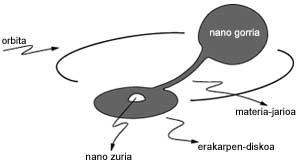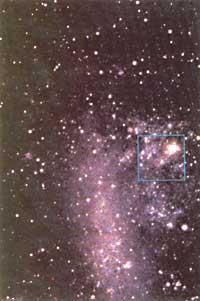X-ray Novas
1994/03/01 Arregi Bengoa, Jesus Iturria: Elhuyar aldizkaria
However, any double star is not suitable for starting this search and the doubles that create X-ray novas are the ones that can give the most compact evidence of the existence of black holes. But let's see before moving forward what the novas are.

Novas and supernovas form a group of variable stars of cataclysm or explosion. As the name suggests, they are due to violent phenomena such as explosions and, as for the processes that emit so much energy, they are very scarce: only 2% of variable stars. Although the novas are much weaker than the supernovas, we also have stars that suddenly shine, or rather, systems formed by two stars. Novas are not newborn stars, although their name suggests it. In most cases, the systems mentioned before appearing as novas are invisible from Earth and their brightness increases sharply and unpredictably by one million. That is why it is called. In a few days, then, they release the energy emitted by the Sun for ten thousand hundred thousand years.
Due to the aforementioned shortage of the phenomenon that we are going to analyze, it is to be assumed that not all double systems become novas or supernovas. On the contrary, although about half of the stars in our galaxy are forming double systems, it is estimated that during the year only about 25 novas are generated. In addition, by avoiding interstellar dust, you cannot see all of them. Currently there are some 150 novas created in the French Way and many other galaxies. The first of the documents cited is the CK Vulpecula, which appeared in 1670.
Those who can create novas are special double systems. Stars must be very close to each other, so they must form small orbits around them. For example, an exemplary double explosive star could have a four-hour orbit. In order to meet these particularities, the stars must also be small.
In most cases, the complete double system would have no solar diameter. We can still say more things. Spectral studies show that these double stars are formed by a white dwarf star and a red dwarf (or sometimes a red giant). Due to the evolutionary epoch in which they are found, white dwarfs are very compact and high density stars. Its density is 10 million, that is, the mass of the Sun in the volume of the Earth. The Reds are losing matter.
The closeness of the two stars mentioned above makes the white dwarf acquire the matter that the other loses, and this creates a disc surrounding the star before it falls into it. In this disc of attraction, due to the action of gravity, matter moves faster and faster, as friction heats matter to very high temperatures.
Later evolution can go two ways: the most common novel or the most dwarf novel. In the case of conventional novas, the explosion occurs on the surface of the white dwarf, when the hot hydrogen that has fallen to it spinning on the disk begins to merge. The enormous energy released by thermonuclear reactions provokes strong explosions and expels abundant matter into space, dispersing. Dwarf novas, on the other hand, produce flash energy in the attraction disk that has formed around them.
The flow of red star matter is considered uniform. Matter accumulates in the disc of attraction and when exceeding a critical level falls at a higher rate than usual. The viscosity reaches a very high level and the heating caused by friction is so large that the disc shines much more than the stars until in the disc the density reaches the initial level. The energy of the dwarf novas comes from the gravitational one. That is why they are 1,000 times weaker than conventional novas.
The main emission of X-ray novels is, logically, that of X-rays. This energy level requires extreme heating and proper gravitational zone. Therefore, it is considered that in many cases the person responsible for the attraction must be more compact than the white nano star, and in some cases measurements have been made that confirm this hypothesis.
X-ray novels lose their special shine in a few months. Then you can easily detect the visionary friend of the collapsed star, which allows to analyze its movement. Therefore, the mass of the motor of this movement can be calculated. In recent years interesting data have been obtained about this problem.
One of the most interesting cases is the J of the IAC (Instituto Astrofísica de Canarias). It belongs to the V404 Cygni X-ray star that Casares and his collaborators have studied. This double star of the constellation Cygnus is located at 7,000 light-years and suffered its rooting process in 1989. According to the aforementioned working group, the mass of invisible collapsed star must be at least 6.26 times greater than that of the Sun. According to Einstein's general theory of relativity, the object with such a large mass after collapse must be a black hole. Therefore, X-ray novas are, for most scientists, the most prolific ways to investigate black holes.
Ephemeris SUN: March 20, 20h to 28min (UT) enters Aries. Spring begins. THE MOON:WANING PADugar 4122027Hora (UT)16 h 53 min. 7 h 5 min 12 h 14 min 11 h 9 minPLANETS MERCURY: throughout the month of March we will have a good chance to see Mercury. It will appear early in the morning before starting to highlight the brightness of the Sun. VENUS: It will also begin to appear at dusk a few minutes at the end of the month, but as we have said, it will disappear immediately behind the Sun. MARTITZ: it appears to us at dawn, but still very low. Therefore, we will have enough difficulty to see it. The sun rises immediately after. JUPITER: it goes towards the opposition, it comes out every time before after darkening and the hours are already more and more comfortable. SATURN: from the middle of the month we can try to find it at dawn; first in the surroundings of Mars and a week later in the surroundings of Mercury, around 24. |

Gai honi buruzko eduki gehiago
Elhuyarrek garatutako teknologia




